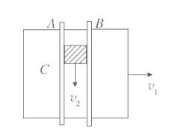问题
选择题
如图所示,质量为m的工件置于水平放置的钢板C上,二者间的动摩擦因数为μ,由于光滑导槽A、B的控制,工件只能沿水平导槽运动,现在使钢板以速度v1向右运动,同时用力F拉动工件(F方向与导槽平行)使其以速度v2沿导槽运动,则:

A.钢板对工件的摩擦力不等于μmg
B.拉工件的力F小于μmg
C.工件与导槽A之间没有弹力
D.工件与导槽B之间没有弹力
答案
BC
题目分析:根据题意可得:工件有相对于钢板水平向左的速度 和沿导槽的速度
和沿导槽的速度 ,根据运动的合成与分解可得:故工件相对于钢板的速度如图所示,
,根据运动的合成与分解可得:故工件相对于钢板的速度如图所示,

滑动摩擦力方向与相对运动方向相反,所以有:
因此F的大小为 ;故A错误,B正确,工件有相对于钢板水平向左的速度,则工件与A没有弹力,故C正确,D错误;
;故A错误,B正确,工件有相对于钢板水平向左的速度,则工件与A没有弹力,故C正确,D错误;
